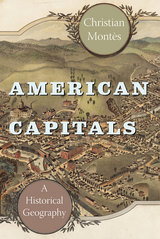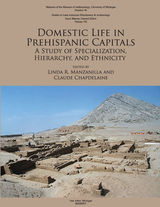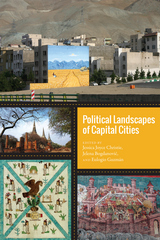3 books about Capitals (Cities)

American Capitals
A Historical Geography
Christian Montès
University of Chicago Press, 2014
State capitals are an indelible part of the American psyche, spatial representations of state power and national identity. Learning them by heart is a rite of passage in grade school, a pedagogical exercise that emphasizes the importance of committing place-names to memory. But geographers have yet to analyze state capitals in any depth. In American Capitals, Christian Montès takes us on a well-researched journey across America—from Augusta to Sacramento, Albany to Baton Rouge—shedding light along the way on the historical circumstances that led to their appointment, their success or failure, and their evolution over time.
[more]

Domestic Life in Prehispanic Capitals
A Study of Specialization, Hierarchy, and Ethnicity
Edited by Linda R. Manzanilla and Claude Chapdelaine
University of Michigan Press, 2009
With major differences in size, urban plans, and population density, the capitals of New World states had large heterogeneous societies, sometimes multiethnic and highly specialized, making these cities amazing backdrops for complex interactions.
[more]

Political Landscapes of Capital Cities
Jessica Joyce Christie
University Press of Colorado, 2016
Political Landscapes of Capital Cities investigates the processes of transformation of the natural landscape into the culturally constructed and ideologically defined political environments of capital cities. In this spatially inclusive, socially dynamic interpretation, an interdisciplinary group of authors including archaeologists, anthropologists, and art historians uses the methodology put forth in Adam T. Smith’s The Political Landscape: Constellations of Authority in Early Complex Polities to expose the intimate associations between human-made environments and the natural landscape that accommodate the sociopolitical needs of governmental authority.
Political Landscapes of Capital Cities blends the historical, political, and cultural narratives of capital cities such as Bangkok, Cusco, Rome, and Tehran with a careful visual analysis, hinging on the methodological tools of not only architectural and urban design but also cultural, historiographical, and anthropological studies. The collection provides further ways to conceive of how processes of urbanization, monumentalization, ritualization, naturalization, and unification affected capitals differently without losing grasp of local distinctive architectural and spatial features. The essays also articulate the many complex political and ideological agendas of a diverse set of sovereign entities that planned, constructed, displayed, and performed their societal ideals in the spaces of their capitals, ultimately confirming that political authority is profoundly spatial.
Contributors: Jelena Bogdanović, Jessica Joyce Christie, Talinn Grigor, Eulogio Guzmán, Gregor Kalas, Stephanie Pilat, Melody Rod-ari, Anne Toxey, Alexei Vranich
Political Landscapes of Capital Cities blends the historical, political, and cultural narratives of capital cities such as Bangkok, Cusco, Rome, and Tehran with a careful visual analysis, hinging on the methodological tools of not only architectural and urban design but also cultural, historiographical, and anthropological studies. The collection provides further ways to conceive of how processes of urbanization, monumentalization, ritualization, naturalization, and unification affected capitals differently without losing grasp of local distinctive architectural and spatial features. The essays also articulate the many complex political and ideological agendas of a diverse set of sovereign entities that planned, constructed, displayed, and performed their societal ideals in the spaces of their capitals, ultimately confirming that political authority is profoundly spatial.
Contributors: Jelena Bogdanović, Jessica Joyce Christie, Talinn Grigor, Eulogio Guzmán, Gregor Kalas, Stephanie Pilat, Melody Rod-ari, Anne Toxey, Alexei Vranich
[more]
READERS
Browse our collection.
PUBLISHERS
See BiblioVault's publisher services.
STUDENT SERVICES
Files for college accessibility offices.
UChicago Accessibility Resources
home | accessibility | search | about | contact us
BiblioVault ® 2001 - 2024
The University of Chicago Press









